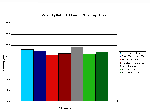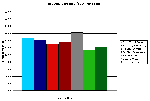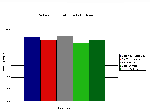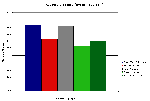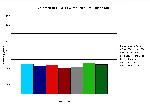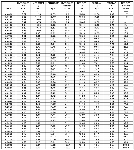November 2002 Article Tennis Server
|

 |
Ball/Court Interaction - Part III
During September, we examined how a ball's approach angle affects its outbound angle as spin rates vary on four different court surfaces (hard, green and red clay, grass). Last month we looked at rebound height and the horizontal distance these same balls attain. The four types of balls used were: Wilson US Open (hard court), Roland Garros (red clay), Slazenger Wimbledon (grass), and Wilson clay court. This month we'll wrap things up and conclude this series by examining ball velocity before and after the bounce on these different surfaces as spin varies.
As a reminder, these were the pre-bounce spin rates used.
There was quite a
variation within each range, however these numbers can be used as a guide.
In the charts below we define "Rebound Distance" as the ball's horizontal distance traveled to reach the ball's maximum rebound height. You can click on the thumbnail charts for full sized graphics. You might want to consider opening additional browser windows to view the larger versions of the chart. (NA means there was no data available in that category.)
Ball Speed Variation With Spin
What do we observe? The more topspin on the ball the less the ball speed is reduced after the bounce. For underspin, aside from the grass court, the more underspin on the ball before the bounce, the greater the reduction in speed. Why the difference? Remember after the bounce just about all balls have topspin on them. A ball hit with underspin is going to change spin direction into topspin after the bounce. Changing direction slows the ball down.
Flat
Velocity Out - Distance
Low Topspin
Medium Topspin
Heavy Topspin
Medium Underspin
Heavy Underspin
The velocity charts were very interesting! Below we've summarized the differences in velocity reduction after the bounce for the "slow" (red clay, green clay and hard courts), versus the "fast" (grass court). The "slow" average is the average of those 3 courts. Keep in mind that a low velocity reduction means that the velocity after the bounce remained closer to the value of the velocity before the bounce. Compare the flat average reduction to the topspin reductions. As we add more topspin, the balls' velocity after the bounce is not reduced as much. You can see the velocity reduction numbers drop from low topspin to heavy topspin. Compare the medium underspin and heavy underspin to the flat and topspin balls. Medium underspin in our study reduced the ball's velocity the most. Look at the reductions for the grass court in the first chart! The results show the following: grass courts reduce the velocity of the ball more than the other courts. How can this be? Grass is supposed to be the "fast" court! Note also that in all cases the grass court velocity in was higher or equal to the other court/ball's velocity in. So what does "fast" mean!
What Does "Fast" Mean? I'll be the first to admit grass courts are a challenge to conduct studies on - just ask any of the folks doing ball/green interaction in golf. After all the grass is "living", it has moisture on it and in it which changes throughout the day. Blades of grass change direction with the sun and with shade. Having seen the pristine manicured courts at Wimbledon, I can tell you the courts we used - well, didn't look like those at Wimbledon. With this in mind, I can say that these are the results our team obtained; under different environmental conditions and on a differently maintained court different results might be seen. On the other hand, other researchers studying typical grass courts (versus Wimbledon) might find this information useful as a comparison. In Part I we discussed the effects we expected to see. According to Professor Howard Brody's book, Tennis Science for Tennis Players, interaction between the ball and the court:
We know that the coefficient of restitution (parameter which deals with ball rebound and bounce) affects the vertical velocity and the coefficient of friction (parameter which deals with the friction effects of the ball rubbing against the court) affects the horizontal velocity. We call the horizontal velocity Vx and vertical velocity Vy. The velocity we have been reporting in our charts has been the total velocity V. We captured Vx and Vy from the video footage and calculated V using the following equation: V=Vx2 + Vy2)1/2. We also used Vx and Vy to get our rebound angle. The rebound angle is a ratio of Vy to Vx.

Prof. Brody's book tells us that more friction means a smaller rebound angle and a faster court. Clearly, we saw much smaller rebound angles on the grass court. What makes a small rebound angle? Look at the diagram below.
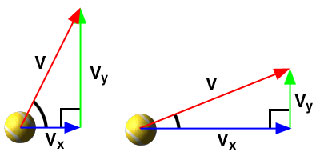
You can see that the smaller the rebound angle the smaller the vertical velocity or the larger the horizontal velocity. A small vertical velocity means a small coefficient of restitution - the ball isn't going to bounce high; a larger horizontal velocity component signifies low friction, a small rebound angle. The large horizontal component of velocity means one more thing - the ball will reach you faster. The diagram below demonstrates this.

In the diagram the different colored balls represent the same point in time. (The red balls are all at the same point in time but not in space; the blue balls are all at the same point in time but not in space , etc.) Let's assume that the balls both have the same velocity when they first bounce off of the court. Court 1 acts like the grass court - its trajectory is a straighter line. Court 2 acts like one of the slower courts - its trajectory is more of a curve. You can see that the red ball has traveled farther on Court 1 in the same amount of time. If you are standing 7 feet away from the ball you will have less time to react to get to the ball. Another short analysis was conducted to prove this. Four of the original (not average) test cases were selected; one for each court type using the US Open ball. In each of these test cases the velocity after the bounce was roughly 19 miles/hour. We examined which ball would reach a player standing at the same position on the different courts, first. We arbitrarily selected 7 feet from the bounce.
The results are clear, the grass court ball not only reached the player first, but it had a faster velocity when it reached the player. This was because its horizontal velocity Vx was faster than the balls from the other courts. There are some very interesting things to note in these charts - and they are fun to play around with. When you open the charts up you will see columns for time, Vx, Vy, V and the distance from the bounce in inches. Seven feet is 84 inches. Go down the distance column for the grass court until you reach 84 inches. (Actually, there is one entry at 83.1 inches and the next entry at 85.3 inches.) Look at the time and velocities: the time is roughly .3 seconds, the horizontal velocity is 15.66 miles/hour, the total velocity is about 15.70 miles/hour. Look at the data for the green court. The ball doesn't reach 84 inches until the time is .337, the horizontal velocity is 13.6 and the total velocity is 14.08. That's almost 2 miles/hour less. The grass ball reaches a player sooner. You have less time to react and that could qualify this grass court as "faster". If you look farther down the grass court court at 98.4 inches from the bounce, you will notice something else, the vertical velocity becomes negative. This means the ball is now dropping. If you look at the green clay court the ball is still climbing. The grass ball starts dropping to the ground sooner than the balls off of the other court - a player has less time to react for this reason as well.
Summary of Results
The Latest Technology
Our tests were conducted using high speed video cameras to capture the ball's behavior with computer software used to calculate the different parameter results at a later time. (I can tell you this was tough on all of our eyes during the analysis phase.) Today, a compact measuring device is used which is able to calculate ball size (radius), the angle and ball velocity before and after the bounce, contact time with the surface, and how far the ball slides when in contact with the surface. The Wassing sestée has been used by the International Tennis Federation, Lawn Tennis Association (the governing body for the game of tennis in Great Britain) and the French Tennis Federation.
Future Article On Shoes
Until Next Month ... Jani
This column is copyrighted by Jani Macari Pallis, Ph.D., all rights
reserved.
Dr. Jani Macari Pallis is the founder and CEO of Cislunar Aerospace,
Inc., an engineering and research firm in San Francisco. In addition
to her engineering practice, she has led two collaborations between
NASA and Cislunar, creating educational materials on the aerodynamics
of sports for pre-college students and educators. As the head of
NASA's "Aerodynamics in Sports" project, she has led a team of
researchers investigating the aerodynamics, physics and biomechanics
of tennis. The group has conducted high speed video data capture at
the US Open and research of ball/court interaction, footwork, serve
speeds, trajectories and ball aerodynamics. Pallis received a BS and
MS from the Georgia Institute of Technology, an MS in mechanical
engineering from the University of California, Berkeley and a Ph.D.
in mechanical and aeronautical engineering from the University of
California, Davis. She is a member of the Executive Committee of The
International Sports Engineering Association.
Questions and comments about these columns can be directed to Jani by
using this form.
|



October 2022 Tennis Anyone: Patterns in Doubles by John Mills. September 2022 Tennis Anyone: Short Court by John Mills. |
 You will join 13,000 other subscribers in receiving news of updates to the Tennis Server along with monthly tennis tips from tennis pro Tom Veneziano.
You will join 13,000 other subscribers in receiving news of updates to the Tennis Server along with monthly tennis tips from tennis pro Tom Veneziano. 


